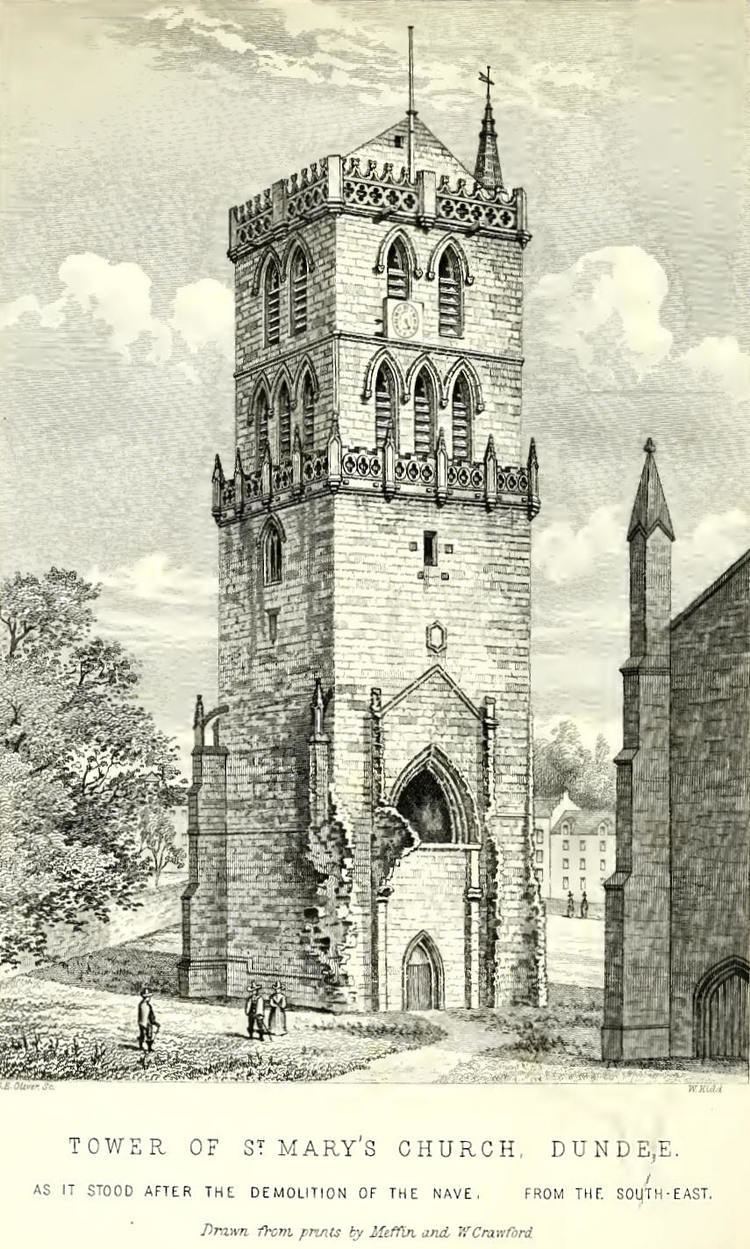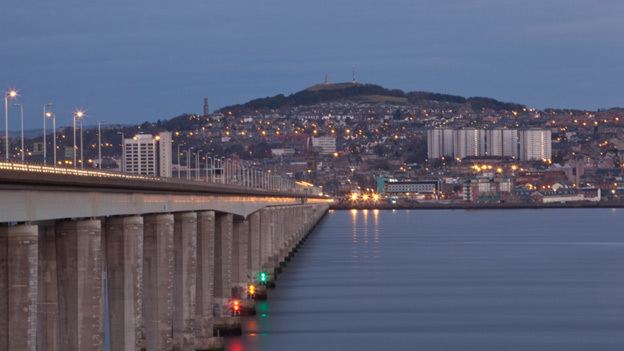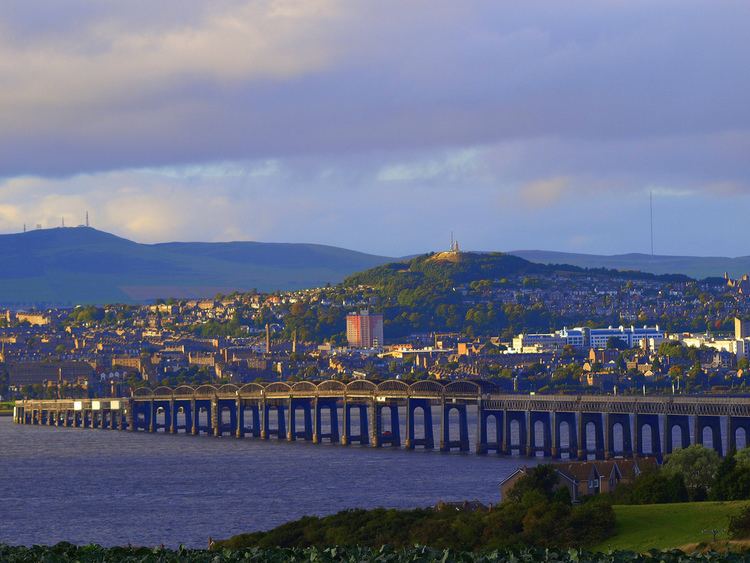Languages spoken OS grid reference, NO4030 Area 147,285 | Population 141,870 (2004) | |
Points of interest Colleges and Universities University of Dundee (Dundee), Abertay University (Dundee), Dundee College (Dundee) | ||
Dundee ( Scottish Gaelic: ), officially the City of Dundee, is the fourth-largest city in Scotland by population. At the 2011 census, it had a population density of 3,298 people per square kilometre, the second highest of any Scottish city. It lies within the eastern central Lowlands on the north bank of the Firth of Tay, which feeds into the North Sea. Under the name of Dundee City, it forms one of the 32 council areas used for local government in Scotland.
Contents
Map of Dundee
The town developed into a burgh in medieval times, and expanded rapidly in the 19th century largely due to the jute industry. This, along with its other major industries gave Dundee its epithet as city of "jute, jam and journalism". Dundees recorded population reached a peak of 182,204 at the 1971 census, but it has since declined to 147,285 according to the 2011 Census.
Today, Dundee is promoted as One City, Many Discoveries in honour of Dundees history of scientific activities and of the RRS Discovery, Robert Falcon Scotts Antarctic exploration vessel, which was built in Dundee and is now berthed in the city harbour. Biomedical and technological industries have arrived since the 1980s, and the city now accounts for 10% of the United Kingdoms digital-entertainment industry. Dundee has two universities—the University of Dundee and the Abertay University. In 2014 Dundee was recognised by the United Nations as the UKs first UNESCO City of Design for its diverse contributions to fields including medical research, comics and video games.
A £1 billion master plan to regenerate and to reconnect the Waterfront to the city centre which started in 2001 is expected to be completed within a 30-year period, with the Dundee Victoria & Albert Museum opening by 2018 at a cost of £80 million.
Dundee is also known for The Dandy, The Beano, Desperate Dan, and Oor Wullie. Visitors wishing to orient themselves should consider taking a walk (or drive) up the Law, Dundee which offers a 360-degree uninterrupted view of Dundee, the Firth of Tay and the Tay Bridge, famously replacing the bridge demolished after the disaster of 1879, and the Tay Road Bridge.
In December 2014; Dundee was named the first city in the United Kingdom to hold the UNESCO City of Design status by the United Nations. Dundee was also voted as the most cultural city in Scotland and the fifth most cultural city in the United Kingdom.
History

The name "Dundee" is made up of two parts: the common Celtic place-name element dun, meaning fort; and a second part that may derive from a Celtic element, cognate with the Gaelic dè, meaning fire.

While earlier evidence for human occupation is abundant, Dundees success and growth as a seaport town arguably came as a result of William the Lions charter, granting Dundee to his younger brother, David (later Earl of Huntingdon) in the late 12th century. The situation of the town and its promotion by Earl David as a trading centre led to a period of prosperity and growth. The earldom was passed down to Davids descendants, amongst whom was John Balliol. The town became a Royal Burgh on Johns coronation as king in 1292. The town and its castle were occupied by English forces for several years during the First War of Independence and recaptured by Robert the Bruce in early 1312. The original Burghal charters were lost during the occupation and subsequently renewed by Bruce in 1327.
The burgh suffered considerably during the conflict known as the Rough Wooing of 1543 to 1550, and was occupied by the English forces of Andrew Dudley from 1547. In 1548, unable to defend the town against an advancing Scottish force, Dudley ordered that the town be burnt to the ground. In 1645, during the Wars of the Three Kingdoms, Dundee was again besieged, this time by the Royalist Marquess of Montrose. The town was finally destroyed by Parliamentarian forces led by George Monck in 1651. The town played a pivotal role in the establishment of the Jacobite cause when John Graham of Claverhouse, 1st Viscount Dundee raised the Stuart standard on the Dundee Law in 1689. The town was held by the Jacobites in the 1715–16 rising, and on 6 January 1716 the Jacobite claimant to the throne, James VIII and III (the Old Pretender), made a public entry into the town. Many in Scotland, including many in Dundee, regarded him as the rightful king.
The economy of mediaeval Dundee centred on the export of raw wool, with the production of finished textiles being a reaction to recession in the 15th century. Two government Acts in the mid 18th century had a profound effect on Dundees industrial success: the textile industry was revolutionised by the introduction of large four-storey mills, stimulated in part by the 1742 Bounty Act which provided a government-funded subsidy on Osnaburg linen produced for export. Expansion of the whaling industry was triggered by the second Bounty Act, introduced in 1750 to increase Britains maritime and naval skill base. Dundee, and Scotland more generally, saw rapid population increase at end of the 18th and beginning of the 19th century, with the citys population increasing from 12,400 in 1751 to 30,500 in 1821.
The phasing out of the linen export bounty between 1825 and 1832 stimulated demand for cheaper textiles, particularly for cheaper, tough fabrics. The discovery that the dry fibres of jute could be lubricated with whale oil (of which Dundee had a surfeit, following the opening of its gasworks) to allow it to be processed in mechanised mills resulted in the Dundee mills rapidly converting from linen to jute, which sold at a quarter of the price of flax. Interruption of Prussian flax imports during the Crimean War and of cotton during the American Civil War resulted in a period of inflated prosperity for Dundee and the jute industry dominated Dundee throughout the latter half of the 19th century. Unprecedented immigration, notably of Irish workers, led to accelerated urban expansion, and at the height of the industrys success, Dundee supported 62 jute mills, employing some 50,000 workers. Cox Brothers, who owned the massive Camperdown Works in Lochee, were one of the largest jute manufacturers in Europe and employed more than 5,000 workers.
The rise of the textile industries brought with it an expansion of supporting industries, notably of the whaling, maritime and shipbuilding industries, and extensive development of the waterfront area started in 1815 to cope with increased demand for port capacity. At its height, 200 ships per year were built there, including Robert Falcon Scotts Antarctic research vessel, the RRS Discovery. This ship is now on display at Discovery Point in the city. A significant whaling industry was also based in Dundee, largely existing to supply the jute mills with whale oil. Whaling ceased in 1912 and shipbuilding ceased in 1981.
While the citys economy was dominated by the jute industry, it also became known for smaller industries. Most notable among these were James Keillers and Sons, established in 1795, which pioneered commercial marmalade production, and the publishing firm DC Thomson & Co., which was founded in the city in 1905 and remains the largest employer after the health and leisure industries. Dundee was said to be built on the three Js: Jute, Jam and Journalism.
The town was also the location of one of the worst rail disasters in British history, the Tay Bridge disaster. The first Tay Rail Bridge was opened in 1878. It collapsed some 18 months later during a storm, as a passenger train passed over it, resulting in the loss of 75 lives. The most destructive fire in the citys history came in 1906, reportedly sending "rivers of burning whisky" through the street.
The jute industry fell into decline in the early 20th century, partly due to reduced demand for jute products and partly due to an inability to compete with the emerging industry in Calcutta. This gave rise to unemployment levels far in excess of the national average, peaking in the inter-war period, but major recovery was seen in the post-war period, thanks to the arrival first of American light engineering companies like Timex and NCR, and subsequent expansion into microelectronics.
A £1 billion master plan to regenerate Dundee Waterfront is expected to last for a 30-year period between 2001 and 2031. The aims of the project are to reconnect the city centre to the waterfront; to improve facilities for walking, cyclists and buses; to replace the existing inner ring road with a pair of east/west tree-lined boulevards; and to provide a new civic square and a regenerated railway station and arrival space at the western edge. A new Victoria and Albert museum is also being built, set for completion by 2018.
Geography

Dundee sits on the north bank of the Firth of Tay on the eastern, North Sea Coast of Scotland. The city lies 36.1 miles (58 km) NNE of Edinburgh and 360.6 miles (580 km) NNW of London. The built-up area occupies a roughly rectangular shape 8.3 miles (13 km) long by 2.5 miles (4 km) wide, aligned in an east to west direction and occupies an area of 60 km2. The town is bisected by a line of hills stretching from Balgay Hill (elevation of 143 m) in the west end of the city, through the Dundee Law (174 m) which occupies the centre of the built up area, to Gallow Hill (83 m), between Baxter Park and the Eastern Cemetery. North of this ridge lies a valley through which cuts the Dighty Water burn, the elevation falling to around 45 m. North of the Dighty valley lie the Sidlaw Hills, the most prominent hill being Craigowl Hill (455 m).

The western and eastern boundaries of the city are marked by two burns that are tributaries of the River Tay. On the western-most boundary of the city, the Lochee burn meets the Fowlis burn, forming the Invergowrie burn, which meets the Tay at Invergowrie basin. The Dighty Water enters Dundee from the village of Strathmartine and marks the boundaries of a number of northern districts of the city, joining the Tay between Barnhill and Monifieth. The Scouring burn in the west end of the city and Dens Burn in the east, both of which played important roles in the industrial development of the city, have now been culverted over.
Economy
The period following World War II was notable for the transformation of the citys economy. While jute still employed one-fifth of the working population, new industries were attracted and encouraged. NCR Corporation selected Dundee as the base of operations for the UK in late 1945, primarily because of the lack of damage the city had sustained in the war, good transport links and high productivity from long hours of sunshine. Production started in the year before the official opening of the plant on 11 June 1947. A fortnight after the 10th anniversary of the plant the 250,000th cash register was produced.
Culture
Dundee is home to a full-time repertory ensemble, which originated in 1939. One of its alumni, Hollywood actor Brian Cox, is a native of the city. The Dundee Repertory Theatre, built in 1982, is also the base for the Scottish Dance Theatre company.

Dundees principal concert auditorium, the Caird Hall (named after its benefactor, the jute baron James Key Caird) in the City Square regularly hosts the Royal Scottish National Orchestra. Various smaller venues host local and international musicians during Dundees annual Jazz, Guitar and Blues Festivals. The Dundee Contemporary Arts, which opened in 1999 in the citys cultural quarter, is home to both an art gallery and art house cinema.
Dundee has hosted the National Mod a number of times – 1902, 1913, 1937, 1959 and 1974.
The citys main museum and art gallery, McManus Galleries, is in Albert Square. The exhibits include a collection of fine and decorative art, items from Dundees history and natural history artefacts. Britains only full-time public observatory, Mills Observatory at the summit of the citys Balgay Hill, was given to the city by linen manufacturer and keen amateur scientist John Mills in 1935. Sensation Science Centre in the Greenmarket is a science centre based on the five senses with a series of interactive shows and exhibits. Verdant Works is a museum dedicated to the once dominant jute industry in Dundee and is based in a former jute mill. The University of Dundee also runs several public museums and galleries, including the DArcy Thompson Zoology Museum and the Tayside Medical History Museum. A new £47 million centre for art and design known as the "V&A at Dundee" is to be built south of Craig Harbour onto the River Tay for completion in 2015. The new museum may bring another 500,000 extra visitors to the city and create up to 900 jobs.
The citys archival records are mostly kept by two archives: Dundee City Archives, operated by Dundee City Council and the University of Dundees Archive Services. Dundee City Archives holds the official records of the city and of the former Tayside Regional Council. The archive also holds the records of various people, groups and organisations connected to the city. The Universitys Archive Services hold a wide range of material relating to the University and its predecessor institutions and to individuals associated with the University, such as DArcy Wentworth Thompson. Archive Services also holds the archives of several individuals, businesses and organisations based in Dundee and the surrounding area. The records held include a substantial number of business archives relating to the jute and linen industry in Dundee; records of other businesses including the archives of the Alliance Trust and the department store G. L. Wilson; the records of the Brechin Diocese of the Scottish Episcopal Church; and the NHS Tayside Archive. The same archive also holds the Michael Peto collection which includes thousands of the photojournalists photographs, negatives, slides, publications and papers.
Dundee is home to DC Thomson & Son Ltd, established in 1905, which produces over 200 million magazines, newspapers and comics every year; these include The Beano, The Dandy and The Press and Journal. Dundee has a strong literary heritage, with several authors having been born, lived or studied in the city. These include A. L. Kennedy, Rosamunde Pilcher, Kate Atkinson, Thomas Dick, Mary Shelley, Mick McCluskey, John Burnside and Neil Forsyth. The Dundee International Book Prize is a biennial competition open to new authors, offering a prize of £10,000 and publication by Polygon Books. Past winners have included Andrew Murray Scott, Claire-Marie Watson and Malcolm Archibald. William McGonagall, regularly cited as the "worlds worst poet", worked and wrote in the city, often giving performances of his work in pubs and bars. Many of his poems are about the city and events therein, such as his work The Tay Bridge Disaster. Dundees poetic heritage is represented by the 2013 poetry anthology Whaleback City edited by W.N. Herbert and Andy Jackson (Dundee University Press) containing poems by McGonagall, Don Paterson, Douglas Dunn, John Burnside and many others.. City of Recovery Press was founded in Dundee, and has become a controversial figure in documenting the darker side of the city.
Dundee has bid to be named 2017 UK City of Culture. On 19 June 2013 it was named as one of the four short-listed cities alongside Hull, Leicester and Swansea Bay.
